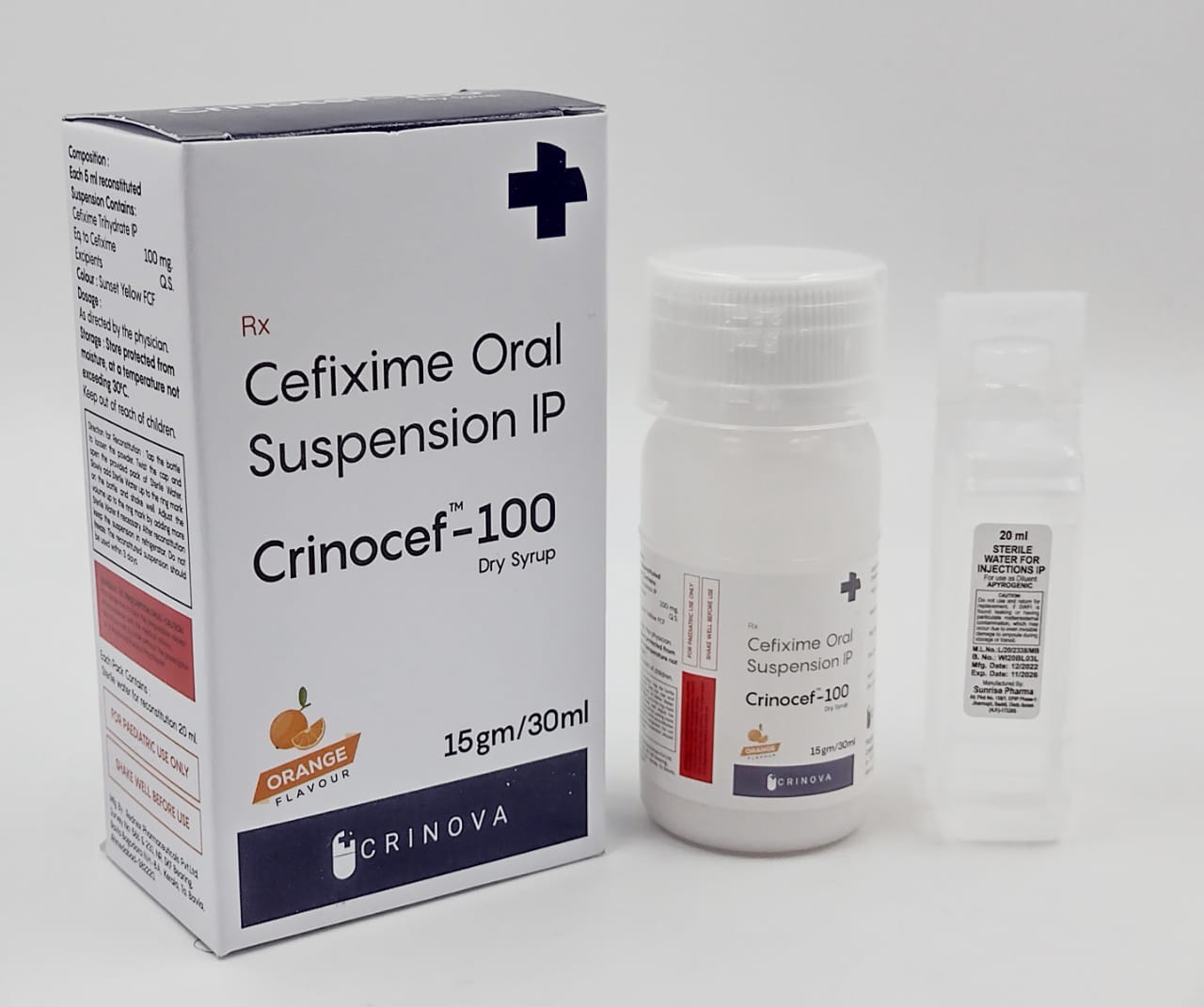INTRODUCTION
CRINOCEF 100 contain Cefixime which belongs to a group of medicine called cephalosporin antibiotics. It is used to treat bacterial infections of ear, nose, sinuses (such as sinusitis), throat (such as tonsillitis, pharyngitis), chest and lungs (such as bronchitis, pneumonia), urinary system (such as cystitis and kidney infections).
It prevents the bacteria from forming the bacterial cell wall which is needed for them to survive. Always take CRINOCEF 100 exactly as your doctor has told you. Check the label for directions before use. Shake well before use.
The common side effects are nausea, vomiting, stomach pain, indigestion or wind, headache, dizziness, feeling itchy in the genital or vaginal area. This medicine should not be given to children under 10 years old. Before taking this medicine tell your doctor if you have ever had kidney disease, heart disease, liver problems. Pregnant and breastfeeding women should consult their doctor before taking this medicine.
USES OF CRINOCEF 100
- Treat bacterial infections
HOW CRINOCEF 100 WORKS
CRINOCEF 100 prevents the bacteria from forming the bacterial cell wall which is needed for them to survive.
DIRECTIONS FOR USE
Always take CRINOCEF 100 exactly as your doctor has told you. Check the label for directions before use. Shake well before use.
SIDE EFFECTS OF CRINOCEF 100
SERIOUS
- Allergic reaction (such as rash, joint pain, swallowing or breathing problems, swelling of your lips, face, throat, or tongue)
- Blistering or bleeding of the skin around the lips, eyes, mouth, nose and genitals, flu-like symptoms, and fever (Stevens-Johnson syndrome)
- Severe blistering rash where layers of the skin may peel off to leave large areas of raw exposed skin over the body, feeling of being generally unwell, chills and aching muscles (Toxic epidermal necrolysis)
- Skin lesions with a pink/red ring and a pale centre which may be itchy, scaly, or filled with fluid. The rash may appear especially on the palms or soles of your feet (erythema multiforme)
- Infections more easily than usual and bruise or bleed more easily than normal (blood disorder)
- Nose bleeds, bleeding gums, chills, tiredness, pale skin (often with a yellow tinge), shortness of breath (haemolytic anaemia)
- Changes in the way the kidneys are working or blood in your child’s urine
- Fits (convulsions)
- Encephalopathy (symptoms such as feeling confused, feeling less alert or aware of things than usual, unusual muscle movements or stiffness)
- Severe watery diarrhoea, feeling weak, fever (Pseudomembranous colitis)
COMMON
- Nausea, vomiting
- Stomach pain, indigestion or wind
- Headache, dizziness
- Feeling itchy in the genital or vaginal area
HOW TO MANAGE SIDE EFFECTS
Nausea and vomiting:
Try taking this medicine with, or just after, a meal or snack and stick to simple meals and do not eat rich or spicy food.
Stomach pain:
Try to rest and relax. You can eat and drink slowly or have smaller and frequent meals. Applying heat pad or covered hot water bottle on your stomach may also help. If still pain persists, speak to your doctor.
Headache:
Apply hot or cold-water bag on your head. Take rest in a quiet and dark room. Drink tea or coffee.
Dizziness:
Get up and move around to feel awake, take small naps to edge off the sleepiness. Give your eyes a break to avoid fatigue and eat a healthy food to boost energy.
Diarrhoea:
Drink lot of fluid such as water or squash, to avoid dehydration. Do not take any other medicines without talking to a doctor.
WARNING & PRECAUTIONS
PREGNANCY
CRINOCEF 100 should be used with caution in pregnant women. Consult your doctor before taking.
BREASTFEEDING
CRINOCEF 100 should be used with caution in breast feeding women. Consult your doctor before taking.
DRIVING AND USING MACHINES
Do not drive or operate any machine while taking this medicine as it may cause fits (convulsions), feeling confused, feeling less alert or aware of things than usual, unusual muscle movements or stiffness.
ALCOHOL
Consumption of alcohol is not recommended during treatment with CRINOCEF 100.
KIDNEY
CRINOCEF 100 should be used with caution in patients suffering from active kidney diseases. Consult your doctor for advice.
LIVER
CRINOCEF 100 should be used with caution in patients suffering from liver function impairment or active liver diseases. Consult your doctor for advice.
ALLERGY
Do not take CRINOCEF 100 if you are allergic (hypersensitive) to Cefixime or any other ingredients in this medicine.
OTHERS
Tell your doctor if you have or had a condition such as,
- Have ever had colitis
INTERACTIONS
Talk to your doctor, if you are taking:
- Medicine such as warfarin (used for thin blood)
SYNOPSIS
| Drug | : | Cefixime |
| Pharmacological Category | : | Antibiotic, Cephalosporin (Third Generation) |
| Therapeutic Indication | : | Bacterial infections |
| Dosage Forms | : | Tablet, Capsule, Injection, Infusion, Oral drops, Syrup |
MORE INFORMATION
Store below 20-25°C and keep out of reach of children.
FAQs ABOUT CRINOCEF 100
Can I take CRINOCEF 100 during kidney disease?
It should be used with caution in patients suffering from active kidney diseases.
Can CRINOCEF 100 cause fever?
Yes, this medicine may cause fever in some individuals. Drink plenty of fluids and water. Avoid taking cold bath or showers.
Can I take CRINOCEF 100 during liver disease?
It should be used with caution in patients suffering from liver function impairment or active liver diseases.



